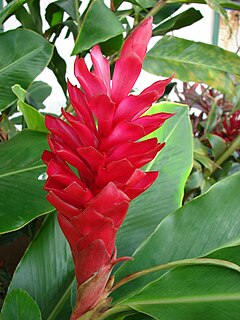
The Zingiberales are flowering plants forming one of four orders in the commelinids clade of monocots, together with its sister order, Commelinales. The order includes 68 genera and 2,600 species. Zingiberales are a unique though morphologically diverse order that has been widely recognised as such over a long period of time. They are usually large herbaceous plants with rhizomatous root systems and lacking an aerial stem except when flowering. Flowers are usually large and showy, and the stamens are often modified (staminodes) to also form colourful petal-like structures that attract pollinators.
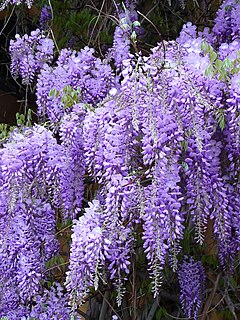
Wisteria is a genus of flowering plants in the legume family, Fabaceae (Leguminosae), that includes ten species of woody climbing vines that are native to China, Korea, Japan, and the Eastern United States. Some species are popular ornamental plants. An aquatic flowering plant with the common name wisteria or 'water wisteria' is in fact Hygrophila difformis, in the family Acanthaceae.

Costaceae, or the Costus family, is a family of pantropical monocots. It belongs to the order Zingiberales, which contains horticulturally and economically important plants such as the banana (Musaceae), bird-of-paradise (Strelitziaceae), and edible ginger (Zingiberaceae). The seven genera in Costaceae together contain about 143 known species. They are native to tropical climates of Asia, Africa, Central America, and South America. Several species are frequently found in cultivation.

Malpighiaceae is a family of flowering plants in the order Malpighiales. It comprises about 73 genera and 1315 species, all of which are native to the tropics and subtropics. About 80% of the genera and 90% of the species occur in the New World and the rest in the Old World.

Polystichum is a genus of about 260 species of ferns with a cosmopolitan distribution. The highest diversity is in eastern Asia, with about 120 species in China alone; the region from Mexico to Brazil has nearly 100 additional species; Africa, North America, and Europe have much lower diversity. Polystichum species are terrestrial or rock-dwelling ferns of warm-temperate and montane-tropical regions.
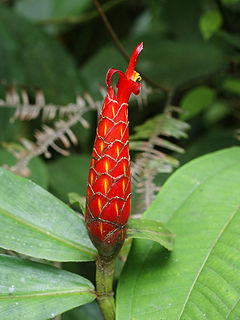
Costus is a group of perennial herbaceous plants in the family (Costaceae) described by Linnaeus as a genus in 1753. It was formerly known as Hellenia after the Finnish botanist Carl Niclas von Hellens. It is widespread through tropical and subtropical regions of Asia, Africa, and the Americas.

Nepenthes glandulifera is a species of pitcher plant endemic to the Hose Mountains of central Sarawak. This plant is so named for the black speckles around the petioles. The species's discoverer, Ch'ien Lee, initially thought they were a sign of disease. After further investigation, it was realised that the black speckles were actually nectar glands. The species is also notable for having a very prominent indumentum. It appears to be closely related to N. pilosa. Nepenthes glandulifera is not known to form natural hybrids with any other species.

Tapeinochilos ananassae is an herb in the Costaceae described as a species in 1866. It is native to Queensland, New Guinea, and the Indonesian Province of Maluku.
Shonia is a genus of plants in the family Euphorbiaceae first described as a genus in 2005. The entire genus is endemic to Australia.
- Shonia bickertonensis(Specht) Halford & R.J.F.Hend. - N NT
- Shonia carinataHalford & R.J.F.Hend. - S Qld
- Shonia territorialisHalford & R.J.F.Hend. - N NT
- Shonia tristigma(F.Muell.) Halford & R.J.F.Hend. - N Qld

Irvingia is a genus of African and Southeast Asian trees in the family Irvingiaceae, sometimes known by the common names wild mango, African mango, bush mango, dika or ogbono. They bear edible mango-like fruits, and are especially valued for their fat- and protein-rich nuts.

Chamaecostus cuspidatus, common name fiery costus or spiral flag, is a species of herbaceous plant in the Costaceae family native to eastern Brazil. In India, it is known as insulin plant for its purported anti-diabetic properties.
Chamaecostus is a group of plants in the Costaceae described as a genus in 2006. It is endemic to South America.

Dimerocostus is a group of plants in the Costaceae described as a genus in 1891. It is native to Central and South America.
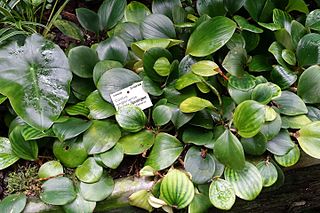
Paracostus is a group of plants in the Costaceae described as a genus in 2006. It is native to Borneo and to tropical Africa.
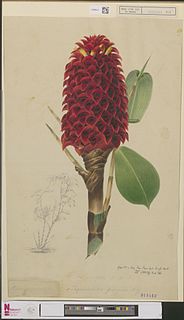
Tapeinochilos is a group of plants in the Costaceae described as a genus in 1869. It is native to Queensland, Papuasia, and the Indonesian Province of Maluku.

Hellenia is a genus of plants in the Costaceae described as a genus with this name in 1791. It is native to Southeast Asia, southern China, the Indian Subcontinent, New Guinea, and Queensland.
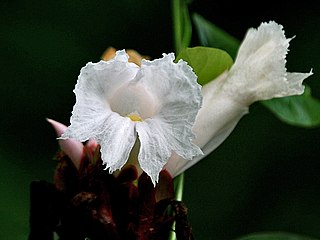
Cheilocostus is a genus in the family Costaceae.
Harperia is a group of plants in the Restionaceae described as a genus in 1904. The entire genus is endemic to the State of Western Australia.
The ginger-families or ginger group or Core Zingiberales is a terminal clade in the order Zingiberales (Monocotyledoneae) that comprises Zingiberaceae, Costaceae, Marantaceae and Cannaceae. Their shared synapomorphy of a single fertile anther and four or five highly modified staminodia differentiate them from the basal paraphyletic assemblage of the "banana-families".

Costus malortieanus is a specie of perennial herbaceous plants in the family Costaceae. It is found in Costa Rica, Nicaragua and Honduras.















